Abstract
Objective
To investigate the mechanism of miR-485-5p inhibiting breast cancer cells by targeting MUC1.
Methods
Differentially expressed genes (DEGs) in breast cancer tissues were analyzed using breast cancer tissue microarrays (TMA) in the GEO database. Differential expression of MUC1 in breast cancer tissue samples was detected by TCGA database. qRT-PCR was used to detect the expression of MUC1 and miR-485-5p in human normal breast epithelial cell lines and human breast cancer cell lines. Bioinformatics was applied to analyze targeted binding site of miR-485-5p and MUC1 and their targeted relationship was identified by dual luciferase assay. The proliferation ability of breast cancer cells was detected by CCK-8 assay. Cell apoptosis was detected by flow cytometry. The ability of cell migration was measured by scratch healing test. Transwell assay was used to detect the invasion ability of cells. The protein expression levels of MUC1 and EMT-related molecules (E-cadherin, N-cadherin and Vimentin) were detected by Western blot.
Results
MUC1 was highly expressed in breast cancer tissue samples and breast cancer cell lines, while miR-485-5p was lowly expressed. Overexpression of miR-485-5p inhibits cell viability and invasion and migration of breast cancer cell line MCF-7 and promotes apoptosis. The same results were obtained by silencing the expression of MUC1. MiR-485-5p targets to bind to the 3′-UTR region of MUC1 and negatively regulates the expression of MUC1. Overexpressing MUC1 while overexpressing miR-485-5p reversed the inhibitory effect of miR-485-5p on breast cancer and inhibited EMT.
Conclusion
MiR-485-5p can down-regulate the expression of MUC1, thus inhibit the proliferation, invasion and migration of breast cancer cells and promote cell apoptosis.





Similar content being viewed by others
References
DeSantis CE, et al. Breast cancer statistics, 2017, racial disparity in mortality by state. CA Cancer J Clin. 2017;67(6):439–48.
Rheinbay E, et al. Recurrent and functional regulatory mutations in breast cancer. Nature. 2017;547(7661):55–60.
Peng Y, Croce CM. The role of microRNAs in human cancer. Signal Transduct Target Ther. 2016;1:15004.
Hata A, Kashima R. Dysregulation of microRNA biogenesis machinery in cancer. Crit Rev Biochem Mol Biol. 2016;51(3):121–34.
Chen CZ. MicroRNAs as oncogenes and tumor suppressors. N Engl J Med. 2005;353(17):1768–71.
Lin XJ, et al. hsa-miR-485-5p reverses epithelial to mesenchymal transition and promotes cisplatin-induced cell death by targeting PAK1 in oral tongue squamous cell carcinoma. Int J Mol Med. 2017;40(1):83–9.
Duan J, et al. The role of miR-485-5p/NUDT1 axis in gastric cancer. Cancer Cell Int. 2017;17:92.
Jing LL, Mo XM. Reduced miR-485-5p expression predicts poor prognosis in patients with gastric cancer. Eur Rev Med Pharmacol Sci. 2016;20(8):1516–20.
Kang M, et al. miR-485-5p acts as a negative regulator in gastric cancer progression by targeting flotillin-1. Am J Transl Res. 2015;7(11):2212–22.
Lou C, et al. MiR-485-3p and miR-485-5p suppress breast cancer cell metastasis by inhibiting PGC-1alpha expression. Cell Death Dis. 2016;7:e2159.
Kufe DW. Mucins in cancer: function, prognosis and therapy. Nat Rev Cancer. 2009;9(12):874–85.
Sinn BV, et al. Evaluation of Mucin-1 protein and mRNA expression as prognostic and predictive markers after neoadjuvant chemotherapy for breast cancer. Ann Oncol. 2013;24(9):2316–24.
Haddon L, Hugh J. MUC1-mediated motility in breast cancer: a review highlighting the role of the MUC1/ICAM-1/Src signaling triad. Clin Exp Metastasis. 2015;32(4):393–403.
Carmon L, et al. Phase I/II study exploring ImMucin, a pan-major histocompatibility complex, anti-MUC1 signal peptide vaccine, in multiple myeloma patients. Br J Haematol. 2015;169(1):44–56.
Kovjazin R, et al. Cell surface-associated anti-MUC1-derived signal peptide antibodies: implications for cancer diagnostics and therapy. PLoS ONE. 2014;9(1):e85400.
Goode G, et al. Correction: MUC1 facilitates metabolomic reprogramming in triple-negative breast cancer. PLoS ONE. 2017;12(6):e0179098.
Mohit E, Hashemi A, Allahyari M. Breast cancer immunotherapy: monoclonal antibodies and peptide-based vaccines. Expert Rev Clin Immunol. 2014;10(7):927–61.
Jing X, et al. Overexpression of MUC1 predicts poor prognosis in patients with breast cancer. Oncol Rep. 2019;41(2):801–10.
von Mensdorff-Pouilly S, et al. Survival in early breast cancer patients is favorably influenced by a natural humoral immune response to polymorphic epithelial mucin. J Clin Oncol. 2000;18(3):574–83.
Bell R, Barraclough R, Vasieva O. Gene expression meta-analysis of potential metastatic breast cancer markers. Curr Mol Med. 2017;17(3):200–10.
Lu H, et al. Human mitotic centromere-associated KINESIN IS TARGETED BY MicroRNA 485-5p/181c and prognosticates poor survivability of breast cancer. J Oncol. 2019;2019:2316237.
Costa FF, et al. Identification of microRNAs as potential prognostic markers in ependymoma. PLoS ONE. 2011;6(10):e25114.
Kim TH, et al. Deregulation of miR-519a, 153, and 485-5p and its clinicopathological relevance in ovarian epithelial tumours. Histopathology. 2010;57(5):734–43.
Merikhian P, et al. MUC1 induces tamoxifen resistance in estrogen receptor-positive breast cancer. Expert Rev Anticancer Ther. 2017;17(7):607–13.
McGuckin MA, et al. Prognostic significance of MUC1 epithelial mucin expression in breast cancer. Hum Pathol. 1995;26(4):432–9.
Yuan H, et al. Mucin 1 gene silencing inhibits the growth of SMMC-7721 human hepatoma cells through Bax-mediated mitochondrial and caspase-8-mediated death receptor apoptotic pathways. Mol Med Rep. 2015;12(5):6782–8.
Fuxe J, Vincent T, Garcia de Herreros A. Transcriptional crosstalk between TGF-beta and stem cell pathways in tumor cell invasion: role of EMT promoting Smad complexes. Cell Cycle. 2010;9(12):2363–74.
Funding
None.
Author information
Authors and Affiliations
Contributions
XWW and XZ conceived and designed the study. FYZ and XTW performed the experiments. HL, XWW and XZ wrote the paper. All the authors read and approved the manuscript.
Corresponding author
Ethics declarations
Conflict of interest
The authors declared that they have no conflicts of interest regarding this work.
Ethical statement
This article does not contain any studies with human participants performed by any of the authors.
Additional information
Publisher's Note
Springer Nature remains neutral with regard to jurisdictional claims in published maps and institutional affiliations.
About this article
Cite this article
Wang, X., Zhou, X., Zeng, F. et al. miR-485-5p inhibits the progression of breast cancer cells by negatively regulating MUC1. Breast Cancer 27, 765–775 (2020). https://doi.org/10.1007/s12282-020-01075-2
Received:
Accepted:
Published:
Issue Date:
DOI: https://doi.org/10.1007/s12282-020-01075-2




